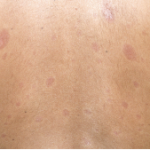My single encounter with EMS occurred one month after the Morbidity and Mortality Weekly Report had reported these first cases. Margaret was a 50-year-old woman who, on the advice of her psychiatrist, had started using L-tryptophan as a sleep supplement. He believed that this was a safer therapeutic alternative than having her continue taking diazepam to help her sleep. Sadly, her demise is best depicted by Dr. Osler’s quotation about scleroderma and mummies. The fatal blow came when Margaret developed a marked axonal neuropathy, resulting in a rapidly ascending polyneuropathy with the development of a near-total quadriplegia. Her tragic battle with EMS finally came to an end.
Recently, with the advent of new imaging techniques, we began witnessing a new disorder, nephrogenic systemic fibrosis (NSF). This generalized fibrotic disease developed in some patients with renal insufficiency following exposure to gadolinium-based contrast agents that were used to enhance magnetic resonance imaging. Clinically, NSF shares many common features with SSc, including severe and usually progressive skin induration, incapacitating joint flexion contractures, and fibrotic involvement of the lungs, heart, and other organs. Recent evidence suggests that exposure to gadolinium-based contrast agents results in the increased production and expression of numerous proinflammatory and profibrotic cytokines, chemokines, and growth factors.8
(For additional information, please refer to “Gadolinium Compounds Provide Insights into Pathogenesis of Fibrosing Diseases” at www.The-Rheumatologist.org.)
EMS, toxic oil syndrome, NFD, and other conditions including eosinophilic fasciitis and graft-versus-host disease can all mimic SSc. Unfortunately, our current understanding of the pathogenesis of these disorders has not led to a deeper understanding of SSc. The mystery remains unsolved.
A Painter’s Legacy
How did Paul Klee’s illness influence his art? In the year that he was diagnosed with SSc, he produced just 25 works, but three years later this number mushroomed to more than 1,200 pieces. What about the nature of his final years? According to Varga, Klee’s creative genius was fundamentally shaped by his illness.2 The lightheartedness and wit of his early works gave way to introspection and despair. Abstract figures were painted with simple, heavy black lines. Some even seemed to be childish or primitive. He abandoned painting intricate, small-scale compositions for much larger pieces. In some of his later art (“The Mask,” 1940, and “Captive,” 1940), the viewer can witness some of the profound changes in Klee’s personal appearance and his sense of being trapped inside a prison. Though Klee was dying and the world around him was collapsing amid the chaos of the Second World War, he found a way to persevere. Like Tithonus, “he withered slowly,” but unlike him, he refused “to be beaten down and marred and wasted.”

